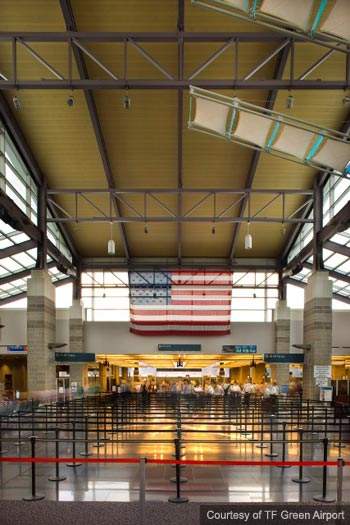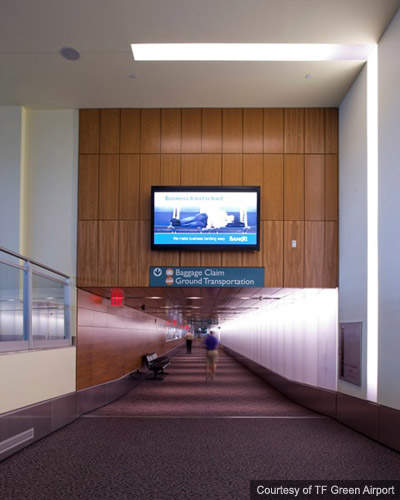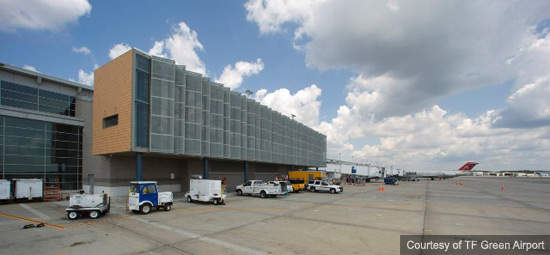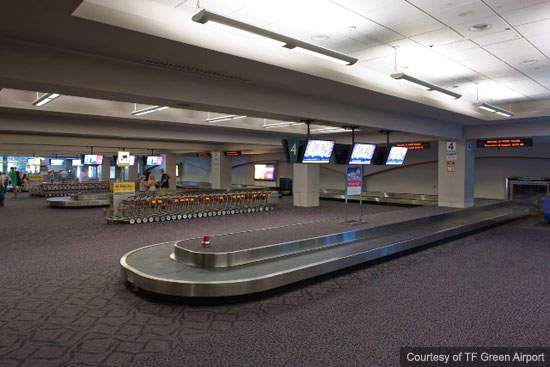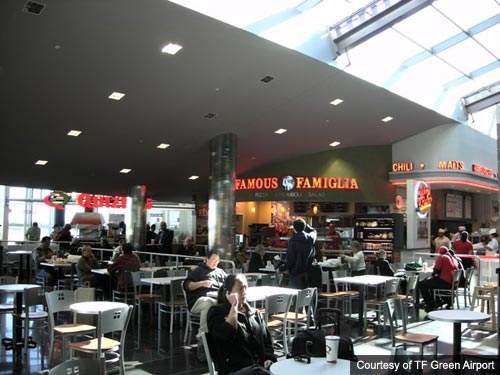TF Green Airport in Rhode Island (Theodore Francis Green State Airport) is situated in the city of Warwick, which is just six miles (10km) south of Providence, in Kent County, Rhode Island.
The airport was first opened in 1931 but was rebuilt in 1996 with the main terminal being completely renovated (in 1998 the 320,000ft² 15-gate facility was expanded to 19 gates and 350,000ft²). The airport was the first that was state owned in the US and is operated by the Rhode Island Airport Corporation (RIAC).
TF Green Airport covers a site of 1,111 acres (450ha) and makes use of two runways (5/23) 7,166ft×150ft, (2,184m×46m) and (16/34) 6,081ft×150ft (1,853m×46m) – in addition, taxiway Victor was in use as runway 5L/23R until 2003.
TF Green is a medium-sized hub to which there has been some diversion of traffic from Boston Logan International Airport; consequently it serves around five million passengers a year and there are 200 daily operations (expected to be 11 million passengers by 2020). The airport has only limited space for expansion because of the amount of residential property surrounding it but some space has now been made on the eastern side of the airport (Cedar Swamp Road and Pembroke Avenue).
TG Green master plan
A master plan was developed in 2001 to identify short and long-term improvements at the airport to improve capacity and relieve the congestion that has been evident since the improvements of 1996-1998. The relatively short length of runway 5/23 is seen as a major hindrance to the development of the airport. Some projects identified for action include resurfacing runway 16/34, the extension of 5/23 to 7,500ft and the eventual extension of 5/23 to 9,500ft.
In addition some improvements were put forward for the terminal along with concourse expansion and parking and roadway infrastructure improvements. The runway extensions have been met with stiff opposition from the residents surrounding the airport as there would be a loss of over 200 houses and a large area of wetland habitat.
Airport expansion
Airport terminal-centred improvements underway at TF Green are mostly to improve bottleneck problems with security. These include: expansion of airline baggage rooms to accommodate a new in-line explosive detection system (EDS) and baggage handling system, which will allow the removal of the EDS equipment in the terminal lobby; expansion of the security screening checkpoint by widening to accommodate eight lanes and lengthening it to give increased passenger screening areas; construction of new exit ramps to allow arriving passengers to move straight to the baggage claim area on the lower level; increased concessions in both the pre- and post-security areas; a new seating area in baggage claim on the lower level; expansion of office space on second and third floor for RIAC staff; more TSA screening stations, and new ticket counters on the north and south sides of the terminal lobby.
The project, occurring between 2006 and 2008, is costing some $83.5m. Skanska USA Building Inc provided construction management services and HNTB Corp is the architect and also the structural, mechanical and electrical engineer while Massey Plate Glass and Aluminium are the glaziers for the project.
TF Green train station
Work began on a railway station to serve the airport in July 2006 (construction being funded from the 2005 Federal highway bill). The airport is almost adjacent to the railway lines 1,250ft away (commuter and Amtrak) and an integrated station was a logical progression. Since 2006 work on the station has stalled for various reasons but in spring 2008 work restarted on the airport station along with a station at North Kingstown near the University of Rhode Island.
The $225m project will see the airport and its main parking garages connected to the station by using an elevated moving sidewalk. Commuter services will start with eight trains a day on weekdays only. The airport will have the closest intercity rail to air link in the US.
Runway foreign object debris detection system
In October 2007 TF Green installed a new foreign object debris (FOD) detection system on their runways. FOD incidents can cause major damage to aircraft and in extreme cases can lead to fatality. The system was provided by QinetiQ and is a Tarsier FOD system that will run 24 hours a day. The system monitors the runway surface and automatically sets off an alarm if objects come to light.
When first installed, the system was able to detect grasshoppers on the runway, which caused false alarms, but this has now been resolved. RIAC provided the site areas for the system and the towers, radar units, computers and software were provided by QinetiQ.

